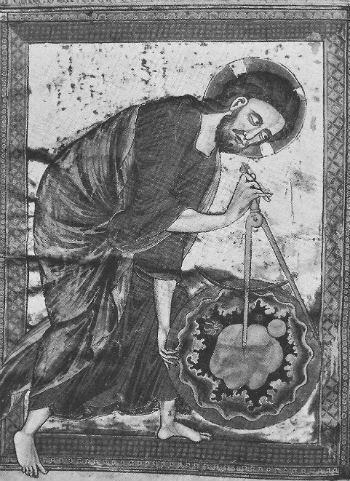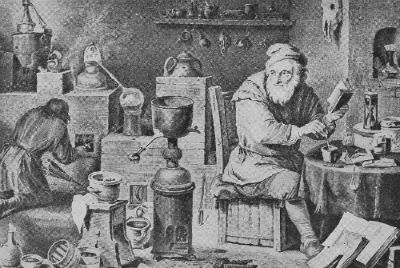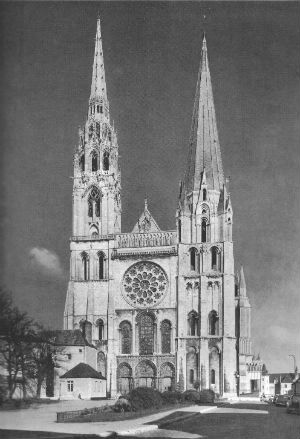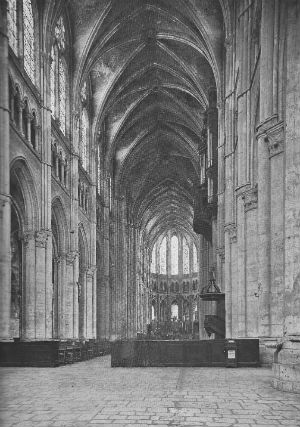Science in the Middle Ages: The Shoulders of Giants
By Neil Earle
 Robert of Lincoln explores refraction in the 1200s.
Robert of Lincoln explores refraction in the 1200s.Granted that I’ve been teaching history off and on for fifty years I do try to be sensitive to the students in my classes who are of a scientific bent.
Our modern approach to knowledge is influenced – like everything from caps and gowns to light swords in Star Wars – by the Middle Ages, that vast torso of our civilization stretching from about 500 to 1500 AD.
Surprisingly, or perhaps not, most of these scientific investigators were Christians coming mostly from within the orbit of the Western Church.
In the Beginning…Necessity?
Let’s begin with John the Grammarian also known as John Philoponus (Greek for “lover of work”). He lived in Alexandria about 450-580 of our era and was probably the last great scientist to thrive in the city famous for Euclid, Archimedes, and Eratosthenes the astronomer. The last about 200 BC calculated the earth’s circumference to within fifty miles of its true diameter!
Aquinas's Five Ways
St. Thomas Aquinas (most famous pupil of Albertus) was the theological superstar of the Middle Ages. He was the greatest product of the universities that were springing up around the cathedral schools of the 1100s and 1200s.He is known even in many philosophy classes for reformulating Aristotle’s evidences for an Unmoved Prime Mover into “five ways” to show God’s existence as entirely plausible. These included:
1. Arguments from Motion. Observation shows us there has to be a cause for every effect. Nothing moves that isn’t moved by something else. That One who doesn’t need to be moved is what humans mean by God.
2. Argument from Causation. All sensible objects are brought into existence by another. The chain of being must start somewhere. Today particle physicists argue that there are quantum elements that spontaneously pop into existence but these, of course, are not observably producing full-fledged universes or complicated human brains. Aquinas helped bring this long-lasting cosmological argument to the fore.
3. The argument from Necesssity. We look around and we see things coming into and going out of existence. With so many things falling out of existence and seemingly unnecessary to exist, it is conceiveable to postulate One Necessary Being who undergirds it all.
4. The argument from Hierarchy. The physical realm shows gradations of being from rocks to plants to humans. God would be the logical next step in the chain. This point is considered the weakest in his presentation.
5. Design demands a designer. The appearance of design in the universe calls for an original supreme Designer. This argument assumes a lot and presupposes that we are reading the material realm correctly in all cases but the idea is very much alive today.
In the end, as Alister McGrath shows, these five ways settle nothing for a dogmatic skeptic but do show the inner logic of belief in God for a believer. They are reasonable “after the fact” arguments. The world mirrors God, Aquinas felt, and the five ways elaborate on that prenise in a forceful and logical way. They also set forth the logical structures of thought and a commitment to scientific method he learned from Albertus Magnus whose motto was “to investigate the causes that are at work in Nature.”
Philoponus came to the attention of the Greek emperor Justinian for defending the church from the ideas of Aristotle who taught the past eternity of matter and Greek ideas of creation through “Necessity” in conflict with Judeo-Christian notions of creation ex nihilo (from nothing by a personal God). Justinian himself exemplified Dark Age and Middle Age science with his building of the magnificient St. Sophia church in his sparkling capital of Constantinople while Western Europe struggled to survive. But Philoponus was his man to rebutt pagan Greek notions of a cold impersonal Unmoved Mover. The Grammarian “liberated Christian thought from the tyranny of the fate, necessity and determinism which for the pagan mind was clamped down upon creaturely existence” (QuodLibet Journal, January 2003).
Optics fascinated Philoponus and he showed how Aristotle’s speculations that vision results from a ray leaving the eye to the object were false. John saw that “the form of the perceived object passes into the eye and is transmitted there by the transparent body (the lens).”
These insights later inspired two scientific leaderswe will meet from the 1200s, Oxford Chancellor Robert Grosseteste (1168-1253), later Bishop of Lincoln, and Roger Bacon (1214-94) who wrote jam-packed treatises on math, astronomy and optics. But they in turn were influenced by the writings of Islamic authors contacted through the Crusades and closeness to Muslim cities in Spain and Italy. Notice Will Durant’s brief synopsis.
The Flight from Magic
In the year 1065, one year before the most famous date in English history – the Norman Conquest of England – an inventor named Oliver of Malmsbury invented an airplane in which he soared briefly before crashing and dying. But progress marches on! In 1091 another cleric named Walcher of Lorraine recorded lunar eclipses with an astrolabe, the first known case of astronomical observation in Europe.
 God as Geometer – a favorite medieval conception.
God as Geometer – a favorite medieval conception.In 1202 Leonardo of Pisa published on Hindu numerals, the zero and the decimal system as well as algebra (Arabic: al-gebra) thus reintroducing mathematics to Europeans.
This advanced the science of mechanics then underway as evidenced by the great cathedrals of the era (see below). Around 1222 the Dominican priest named Jordanus extended Leonardo’s insights by formulating the still-used axiom of Jordanus: “that which can raise a certain weight to a certain height can raise a weight K times heavier to a height K times less” which has the ring of scientific method about it.
By 1271 Robert of England was stating the theory of the pendulum clock and a great clock is mentioned in a tower at Westminster. The first clear mention of a clock dependent on pulleys, weights and gears dates to 1320. The famed rotating clocks of the later Middle Ages were on their way.
About 1270 Mark the Great compiled the recipe for gunpowder – one pound of live sulphur, two pounds of charcoal from a lime or willow tree, with six pounds of saltpeter. Mix and stir. The Chinese claim to invent gunpowder may well be verdone.
Arnold of Villanova (1235-1311) in Spain was the famed physician of the period, successfully treating the Pope for kidney stones. Surgery advanced more rapidly than any branch of medicine in this era and even though nuns and monks had won renown as Europe’s first pharmacopeiasts, Roger of Salerno, published, about 1170, the earliest treatise on surgery in Western Europe.This remained a text for three hundred years. After all, Iraqi doctors were performing brain surgery in the 800s AD so this fits the pattern of borrowing from the East.
Christian charity gave a great spin to the hospital movement and the first English hospital was established at Canterbury in 1084 and when the King of France established a space for the sick in 1260 he began the most enduring medical center in Paris.
These are impressive feats and undermining the old lie that the Church was hostile to science. True, Rome worried about astrology creeping into these ventures and many learned men adopted these dark arts (along with some sillier speculations) but overall, concludes Durant, these are major achievements for this pre-technological period.
 Medieval apothecary in his makeshift lab.
Medieval apothecary in his makeshift lab.“The Little Renaissance”
The 1200s is famous for seeing what Stephen Cantor calls “the dim beginnings of modern science,” but this is an understatement. Once again, knowledge of all kinds was stirred by the contact with Muslims thinkers – the transmitters of the legacy of Greece and Rome, expedited by the Crusades and the growing stability in Western Europe. One concrete result was the cathedral building movement and the formation of schools that surrounded them – such as Oxford, Cambridge and the Universities at Paris and Bologna. The 1100s and 1200s were the great epoch of cathedral building.
Tourists in Europe stand in awe as they gaze upwards to the pointed arches, the high windows, the vast airiness of the artistically blended beams and roofing supports gazed at hindreds of feet below from the massive enclosed spaces of such edifices as Chartres, Notre Dame, Durham and Exeter. Kenneth Clark comments that “to medieval man geometry was a divine activity, God was the great geometer, and this concept inspired the architect.” The craftsmanship and measureable harmonies of the great cathedrals with their soaring Gothic towers and flying buttresses in support of the vast spires and rose-shaped windows “reflect a more complex mathematics than one is inclined to believe.”
 Chartres Cathedral south of Paris – an 1184 masterpiece.
Chartres Cathedral south of Paris – an 1184 masterpiece.These massive and beauteous edifices were not just sermons in stone for the attending crowds, they were and are testimonies to the learning and scholarship behind these fluted stone monuments that are the pride of their host cities to this day. “They didn’t trust cement; brick and mortar was deemed too messy for God’s house and crumbled in time,” says technologist Roger G. Lippross. “Stone blocks had to be carved intricately and aligned in ways we still puzzle over.” When St. Patricks’s cathedral was raised in New York in the middle 1800s, it measured 396 feet long and stoof 329 feet high at the apex and took twenty years to finish – the same amount of time it took to get Chartres started between 1145 and 1194 it’s roughly 430 feet in length and 105 feet in width supporting 176 stunning stained glass windows.
Lippross is of the opinion that some of those medieval secrets of ratios of height and weight are lost to us today.
“The Brilliant Foursome”
Albertus Magnus in Cologne laid down fundamental scientific principles we still adhere to, such as the confirmation of theories by observation and predictability. This was the road ahead. His most famous pupil, Thomas Aquinas, laid out five ways to show God’s existence in nature which gave a spin to the link between science and religion that still endures (see Box).
On a parallel track, Grosseteste and Bacon published voluminously. Though making many wrong conclusions, Grossetetste set forth theories of scientific method that still guide students of physics. He anticipated the Big Bang with his educated speculations that the universe could have begun with a giant explosion and then – foreshadowing Newtonian gravity – the matter then released slowly settled down into a series of nested spheres (the planets). But his speculations rested on a commitment to experimentation and observation. The Bishop studied the refraction of light through a glass lens. He popularized the astrolabe used in Muslim Spain as an early form of the sextant. This handy tool determined the altitude of heavenly bodies and calculated latitude and opened up later sailing ventures into the North Atlantic.
There may have been flat-earth fanatics in the Middle Ages but Robert Grosseteste was not one of them.
 The grandeur of enclosed space – Chartres interior.
The grandeur of enclosed space – Chartres interior.Blending Genesis 1:2 with Aristotle’s theories Bishop Robert wrote extensively on light as the first form to come into existence (a different species, he believed, than the everyday light we experience). This touting of light as the key to all phenomena was perhaps walking on Einstein’s grave seven centuries in advance. He demonstrated that light “extends matter on all sides.” It is “common to all things in the universe from the lowest elements including even the firmament “(Reidl, page 6).
Robert sat at the beginning of mathematical physics with his extensive writings on geometry. “Without lines, angles and figures,” he wrote, “there is no true scientific means of measurement and verification.” His pupil Roger Bacon of Oxford became famous building on his teacher’s insights. “Rays of heat and sound penetrate through the walls of gold and brass,” he wrote, a most modern-sounding insight. Bacon’s reflections on optics included laws of refraction, magnification and telescopy. This inspired Leonard Digges in the middle 1500s to invent the telescope. Once Galileo came along with his own lenses, modern science took off.
Meanwhile in Germany, Albert was grinding out 38 fat volumes on everything from how a decapitated cock can continue to sing to why the earth is a sphere. He showed that the Milky Way consisted of stars, pointed out the relationship between the nerves and the brain in head wounds, showed how a spider senses a fly at great distances and explained the mode of vision of undersea animals. This would make him what we call a “renaissance man” centuries before Leonardo. The medieval scientists of the 1200s tuned in to acute observation left behind the legacy that scientific theories must pass the demonstration test, ideally through mathematical theorems.
All about them were practical evidences of their mathematical and geometric studies. The great cathedrals are part of their legacy and still inspire us today.
SOURCES:
Kenneth Clark, Civilization
Francis Collins, The Language of God
Will Durant, The Age of Faith
Clare Reidl, Robert Grosseteste on Light
J. Truman, Britain: The Growth of Freedom
James Weisheipl, Albertus Magnus and the Sciences